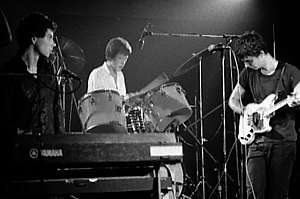Avant-funk
Avant-funk is a music style in which artists combine funk rhythms with an avant-garde or art rock mentality.[2] Its most prominent era occurred in the late 1970s among post-punk acts who embraced black dance styles.[3]
| Avant-funk | |
|---|---|
| Stylistic origins | |
| Cultural origins | 1960s, United Kingdom and United States |
| Derivative forms | House, drum and bass |
| Other topics | |
Characteristics
Critic Simon Reynolds described avant-funk as "difficult dance music" and a kind of psychedelia in which "oblivion was to be attained not through rising above the body, rather through immersion in the physical, self loss through animalism."[2] Simon Frith described avant-funk as an application of progressive rock mentality to rhythm rather than melody and harmony.[2] Some motifs of the style in the 1970s and 1980s included "Eurodisco rhythms; synthesizers used to generate not pristine, hygienic textures, but poisonous, noisome filth; Burroughs’ cut-up technique applied to found voices."[2]
History

Early acts who have retrospectively been described with the term include German krautrock band Can,[4] American funk artists Sly Stone and George Clinton,[5] and jazz trumpeter Miles Davis.[6] Herbie Hancock's 1972 album Sextant was called an "uncompromising avant-funk masterpiece" by Paste.[7]
According to Reynolds, a pioneering wave of avant-funk artists came in the late 1970s, when post-punk artists (including Public Image Ltd, Liquid Liquid, and James Chance, as well as Cabaret Voltaire, Talking Heads, The Pop Group, D.A.F., A Certain Ratio, and 23 Skidoo)[8] embraced black dance music styles such as funk and disco.[3] Reynolds noted these artists' preoccupations with issues such as alienation, repression and the technocracy of Western modernity.[2] The artists of the late 1970s New York no wave scene also explored avant-funk, influenced by figures such as Ornette Coleman.[1]
Later groups such as Skinny Puppy, Chakk, 400 Blows represented later waves of the style. By the mid 1980s, it had dissipated, with many of its practitioners becoming a part of the UK's first wave of house music.[8] Avant-funk would go on to influence '90s drum and bass producers such as 4hero and A Guy Called Gerald.[9]
See also
References
- Murray, Charles Shaar (October 1991). Crosstown Traffic: Jimi Hendrix & The Post-War Rock 'N' Roll Revolution. Macmillan. p. 205. ISBN 9780312063245. Retrieved 6 March 2017.
- Reynolds, Simon (February 13, 1987). "End of the Track". New Statesman.
- Reynolds, Simon (2006). Rip It Up and Start Again: Postpunk 1978-1984. Penguin. ISBN 9781101201053.
avant-funk sly stone.
- Reynolds, Simon (1995). "Krautrock Reissues". Melody Maker. Retrieved 5 March 2017.
- Staff. "Passings". Billboard (116). Nielsen. Retrieved 5 March 2017.
- Gluckin, Tzvi. "Forgotten Heroes: Pete Cosey". Premier Guitar. Retrieved 27 April 2017.
- Jarnow, Jesse. "Herbie Hancock: Cafe Curiosity". Paste. Retrieved 1 August 2020.
- Reynolds, Simon (2012). Energy Flash: A Journey Through Rave Music and Dance Culture. Soft Skull Press. pp. 20, 202. ISBN 9781593764777. Retrieved 5 March 2017.
- Staff (February 1995). "Return Of The Gerald". Mixmag (45).